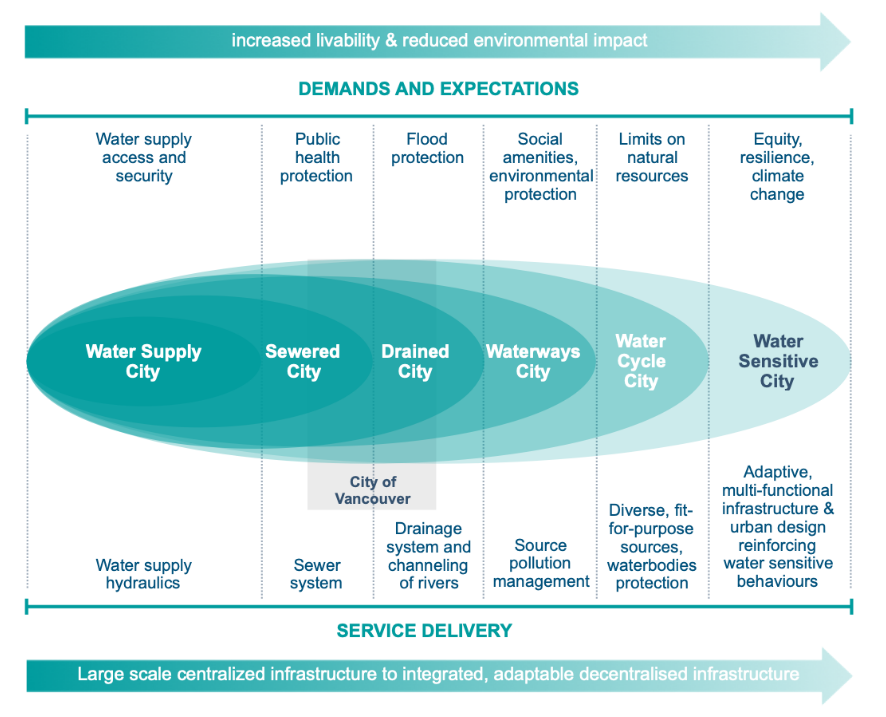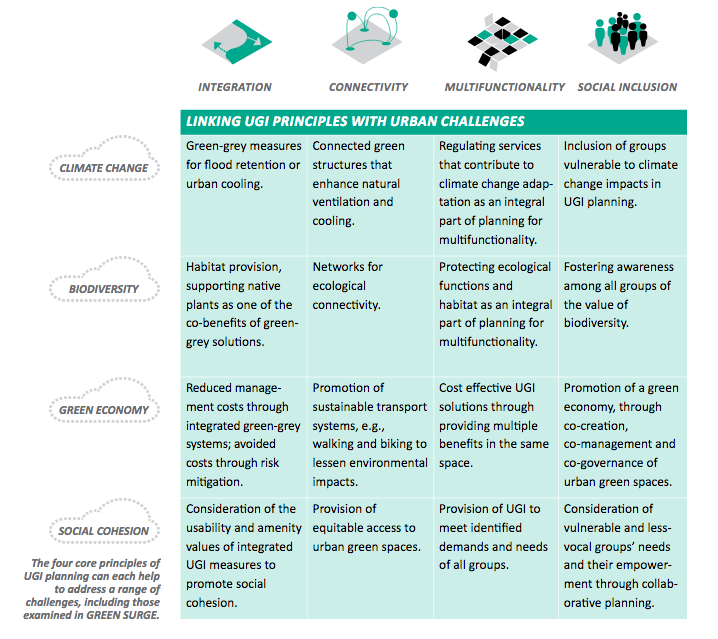Module 8: Planning Principles and Communicating GI Solutions
Learning Objectives
- GI Planning
- Communicating GI Solutions
Successfully integrating GI into urban planning, as we can see from the examples of the Cities of Vancouver and Rotterdam, requires adaptive management. Adaptive management for GI calls for “embedding water sensitive values, behaviours and design principles into city wide systems planning” e.g., sewer and drainage systems, transportation, parks and natural assets of the community. Taking into account the water cycle and the built environment, adaptive management is a form of planning that is flexible and responsive, as well as interdisciplinary — involving not only engineers, but architects, economists, urban designers, construction, citizens and even artists.
Exploring Rainwater Values
Source: URBAN WATER TRANSITION FRAMEWORK. Adapted from“ Urban Water Management in Cities” T.H.Wongetal, 2009, Water Science and Technology, 59(5), page 85.
As the ‘Making it Happen’ chapters explores green-to-grey integration, whether for stormwater management or urban cooling. This integration is not only connected to climate change adaptation; it is also concerned with enhancing ecological connectivity and protecting biodiversity. “A socially inclusive planning process might not guarantee a socially cohesive community – but it is an important step towards one.” As you can see from the matrix below, green infrastructure or urban green infrastructure (UGI) addresses urban challenges by applying the principles of integration, connectivity, multifunctionality and social inclusion.
Source: UGI Planning Guide
This module provides examples of municipalities that are creating new ways of communicating and encouraging green infrastructure solutions. From online technical design manuals to public outreach and volunteer programs, green infrastructure is motivating municipalities to rethink the opaque engineering manuals traditionally used for infrastructure management. And these approaches are being woven into urban planning practices.
In Ontario, the Sustainable Technologies Evaluation Program has developed a comprehensive online resource for GI professionals to easily access new information and changing best practices. In Minnesota, an ever-growing collection of green infrastructure guidance and resources led to the complete digitization of a traditionally hard copy document. The San Francisco Public Utilities Commission now has its Stormwater Control Plan guidance, GI calculators, background information and guidebooks, in a centrally available online database. (These resources are located in the Additional Readings tab).
Successful municipal planning for GI requires the understanding and support of local residents. The World Bank reading provides an international context for the ways that local communities are key to successful GI implementation. The Blue Green Cities chapter on best practices provides an overview of GI in municipalities. Key findings from the City of Vancouver’s Rain City Strategy provide insight into how integration of GI works ‘on the ground’ and the projects funded by the Federation of Canadian Municipalities offer insights into a range of innovative GI projects.
Learning Activities
- Read the articles provided.
- Scan the additional readings
Discussion Question
- From your readings in this module or cases highlighted in past modules, what urban centre does an exceptional job at communicating the power and potential of urban green infrastructure because it integrates well with existing infrastructure, promotes connectivity and/or multifunctionality or fosters social inclusion?
Readings & Resources
Readings
- Integrating Green and Gray (World Bank, 2018):
- Why Integrate Green and Gray Infrastructure – The Social Foundation of Green Infrastructure pg. 41-51

- Why Integrate Green and Gray Infrastructure – The Social Foundation of Green Infrastructure pg. 41-51
- Blue and Green Cities:
- The Role of Blue-Green Infrastructure in Managing Urban Water Resources – Best Practices – pg. 291-303
- Green Planning for Cities and Communities:
- Renaturing Cities – 23 pages
- Urban Green Infrastructure Planning:
- A Guide for Practitioners Making it Happen: pg. 43-55

- A Guide for Practitioners Making it Happen: pg. 43-55
- Core Principles of UGI Planning from EU GreenSurge Guide (pg.22-42)
- Review the funded projects for 2020 by The Green Municipal Fund (GMF) a $1-billion program funded by the Government of Canada and delivered by FCM.
- Vancouver Rain City Strategy – Key Findings (6 pages)
Additional Resources and Citations
- EPA – Overcoming Barriers to Green Infrastructure Implementation
- Shandas, V., Matsler, A. M., Caughman, L., & Harris, A. (2020). Towards the implementation of green stormwater infrastructure: Perspectives from municipal managers in the Pacific Northwest. Journal of Environmental Planning and Management, 63(6), 959–980.
- Tackling Barriers to Green Infrastructure: An Audit of Municipal Codes and Ordinances
- Minnesota Stormwater Management Resources
- Minnesota Stormwater Best Practices
- Minnesota Stormwater Manual
- University of Minnesota Watershed Game
- Lieberherr, E; Odom Green, O. (2018). Green Infrastructure through Citizen Stormwater Management: Policy Instruments, Participation and Engagement. Sustainability, 10(6), 2099. https://doi.org/10.3390/su10062099
- Wilker, J., Rusche, K., & Rymsa-Fitschen, C. (2016). Improving Participation in Green Infrastructure Planning. Planning Practice & Research, 31(3), 229–249. https://doi.org/10.1080/02697459.2016.1158065
- Dhakal, K. P., & Chevalier, L. R. (2017). Managing urban stormwater for urban sustainability: Barriers and policy solutions for green infrastructure application. Journal of Environmental Management, 203(Pt 1), 171–181.https://doi.org/10.1016/j.jenvman.2017.07.065
- Lennon, M. (2015). Green infrastructure and planning policy: A critical assessment. Local Environment, 20(8), 957–980. https://doi.org/10.1080/13549839.2014.880411
- Thomas Beery. (2018). Engaging the Private Homeowner: Linking Climate Change and Green Stormwater Infrastructure. Sustainability, 10(12), 4791. https://doi.org/10.3390/su10124791



